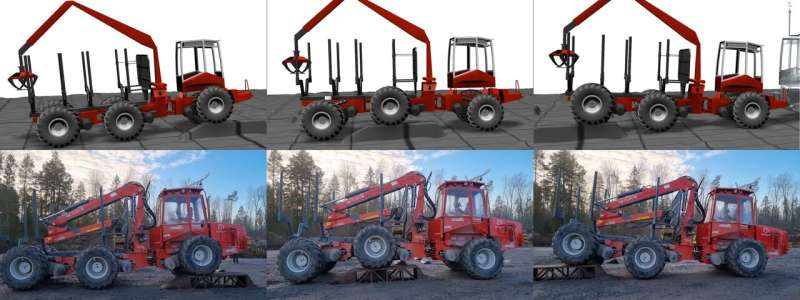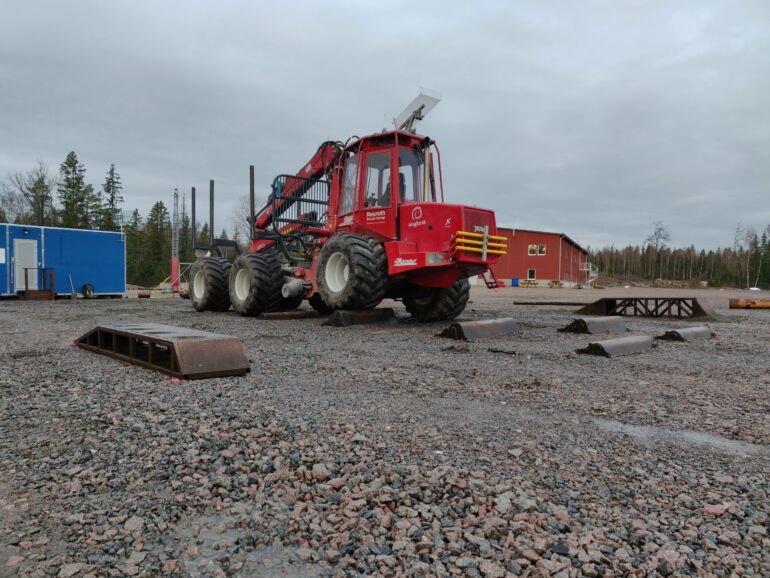For the first time, scientists have succeeded in creating a self-driving forest machine controlled by artificial intelligence. In a study at Umeå University, an AI system was developed that can operate a 16-ton machine without human intervention.
The study has been carried out in collaboration with Skogforsk and Algoryx Simulation. The work is published in the journal Robotics and Autonomous Systems.
AI control of robots requires large amounts of training data, which is costly and risky when it comes to heavy machines. Pre-training in a simulated environment solves this, but there is always some discrepancy with reality.
A research study at Umeå University shows that this obstacle can also be overcome for large and complex systems. At Skogforsk’s test site in Jälla outside Uppsala, the first successful trials have been carried out.
In the tests, an AI was given the task to control a heavy forest machine, navigate over various obstacles, and follow a planned route. The AI had been trained in advance on Umeå University’s supercomputer in several million training steps.
“The results show that it is possible to transfer AI control to a physical forest machine after first training it in a simulated environment,” says Viktor Wiberg, researcher at Algoryx Simulation, whose doctoral thesis at Umeå University forms the basis of the work. This is the first time that someone has succeeded in demonstrating autonomous control of a machine as complex as a forestry machine using AI.
The AI needs to be trained in a virtual environment
The AI method “deep reinforcement learning” has demonstrated super-human capability in controlling complex systems. However, successes have been limited to either digital systems or small and lightweight robots. Heavy equipment for forestry, mining, construction have complex mechanics, often in combination with hydraulics. This makes them difficult to control.
“In addition, it is costly and dangerous to experimentally produce the amount of training data required to train AI models that can handle all conceivable situations,” says Martin Servin, associate professor in physics at Umeå University.

Comparison between the simulated and real forestry machine travelling over a high ramp, controlled by the same AI model (Policy C2). The model endeavours to maintain a steady speed toward the next target point with good and evenly distributed ground contact. It reacts to the power variations of the hydraulic system and laser data of the local environment. © Viktor Wiberg
For these reasons, much of the research and development takes place in virtual training environments, not unlike the kind of simulators that have long been used to train human machine operators. The virtual environment is based on physics simulation that faithfully calculates the machine dynamics and the interaction with terrain and tree logs.
Study shows that the ‘reality gap’ can be bridged
In a digital simulation, an AI model can in short time explore a large space of causal relationships between situation, action and outcome.
“In a virtual environment, the training takes place without risk of injury and without fuel consumption,” says Servin.
But despite a high degree of realism in the physics models that drive the simulations, there is a certain discrepancy with reality. This so-called “reality gap” constitutes a major obstacle when a pre-trained model is to be transferred to control a physical machine. The result may be that the AI performs unexpected and unwanted actions.
Until now, it has been unclear how big an obstacle the reality gap is when it comes to heavy and complex machines. But the research study at Umeå University shows that the gap can be bridged.
“It is impressive that it actually worked. It was clear how the AI performed better and better with each trial,” says Tobias Semberg, engineer at Skogforsk Troëdsson Forestry Teleoperation Lab. The research will be presented during the world congress in forest research, IUFRO, in Stockholm.
More information:
Viktor Wiberg et al, Sim-to-real transfer of active suspension control using deep reinforcement learning, Robotics and Autonomous Systems (2024). DOI: 10.1016/j.robot.2024.104731
Citation:
AI system successfully operates 16-ton forest machine (2024, June 20)



